- Home
- Technical Cooperation Projects
- Index of Countries
- Middle East
- Egypt
- Project for Strengthening Water Management Transfer
- Project News
- Counterpart Training Course on "Water Resources Management in Japan" was implemented.
Project News
2015-03-16
Counterpart Training Course on "Water Resources Management in Japan" was implemented.
Project for Strengthening Water Management Transfer (SWMT Project) implemented the Counterpart Training Course on "Water Resources Management in Japan" from February 28 to March 11, 2015. The objectives of the training were to provide for the trainees chances to directly see activities on water resources management in Japan and deepen their recognition of Water Management Transfer (WMT) that they will achieve in Egypt. There were four Egyptian trainees including General Manger of Foreign Finance Department in the Planning Sector of MWRI and three Undersecretaries of Central Department of Water Resources and Irrigation (CDWRI) under which each of the three pilot sites of the Project is located, and all of them are decision makers of the Ministry of Water Resources and Irrigation (MWRI) who play important roles in implementing the project activities at the pilot sites as well as in developing the roadmap of WMT. With Eng. Naito, Chief Advisor of the SWMT Project, they visited several relevant organizations such as two Land Improvement Districts (LIDs) of Ryoso and Toyogawa, Ministry of Agriculture, Forestry and Fisheries (MAFF) of Japan and Japan Water Agency to learn about Japanese land improvement projects and operation and maintenance (O&M) of water facilities.
On the first day, the trainees visited the Rural Development Bureau of MAFF. They performed a courtesy call and had a lecture on Agricultural and Rural Development in Japan.
On the next day, they visited Teganuma LID where Stock Management Project has been implemented to rehabilitate main irrigation facilities including pumps in Inzai-city of Chiba Prefecture after having a lecture on the Stock Management at Tone River Basin Land Improvement Planning and Management Office of Kanto Regional Agricultural Administration Office. The Stock Management is a method to enhance durability of irrigation facilities and lower the rehabilitation cost by implementing periodical functional diagnosis and by effective and preventative maintenance of those facilities. In Japan, since most of irrigation facilities were constructed in the period from 1940s to 1960s, they have passed their useful life and need to be rehabilitated. That is why the Stock Management has been actively implemented nationwide in Japan these days. On the other hand, because the trainees also have the same problem on degrading of the irrigation facilities in Egypt, they were seriously listening to the lectures on theories and practice of the Stock Management. For the Stock Management, it is necessary to manage the water facilities in more detailed ways through the daily maintenance and periodical functional diagnosis. It is hoped that the trainees will be able to actively discuss concrete ways to manage the irrigation facilities by farmer's participation.
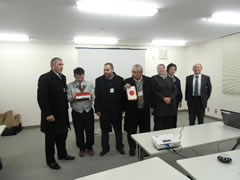 Tone River Basin Land Improvement Planning and Management Office
Tone River Basin Land Improvement Planning and Management Office
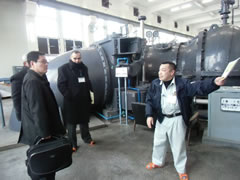 Teganuma LID
Teganuma LID
In the Ryoso LID, the trainees had lectures on roles of the Project as well as on organization and roles of the LID and visited the main irrigation facilities. Since the Ryoso LID has its long history to implement human exchange with the Egyptian Counterparts (CPs) through the CP trainings and dispatch of the short-term experts of JICA, the trainers explained about their activities of LID by using the DVD with Arabic caption which enabled the trainees to well understand the lectures.
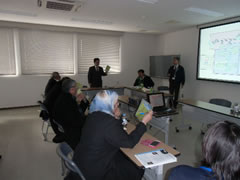 Lecture in the Ryoso LID
Lecture in the Ryoso LID
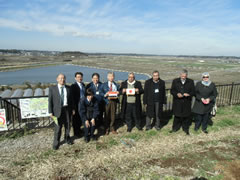 Kuriyamagawa Integrated Pump Station
Kuriyamagawa Integrated Pump Station
Thereafter, the trainees moved to Toyohashi-city in Aichi Prefecture and visited the Department of Toyogawa River System, Shinjo and Toyohashi Branch Offices of Japan Water Agency to have lectures on construction of facilities, roles of the stakeholders in management of the system and planning and implementation of water distribution. After visiting the main facilities including Muromatsubara Weir and Manba Reservoir, organization and roles of LID were lectured by the Toyogawa LID. It was very effective for the trainees to consistently visit and see those facilities from the main facilities to tertiary canal, while confirming every organization in charge of each facility as well as contents of management.
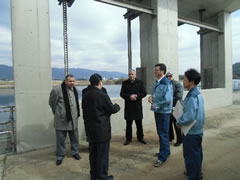 Muromatsubara Weir
Muromatsubara Weir
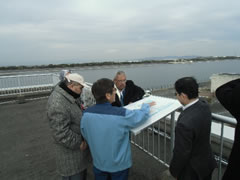 Manba Reservoir
Manba Reservoir
After returning to Tokyo, the trainees visited the Naramata Dam in Minakami-town of Gunma Prefecture. Having lectures on structure and operation of the dam at the Operation Office of the Naramata Dam under the Japan Water Agency, they visited the Museum and the inside of the Dam. Since it was the first time for most of the participants to see snow, it must have been a good memory to see the beautiful large dam covered with snow.
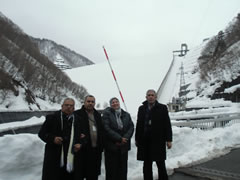 Naramata Dam
Naramata Dam
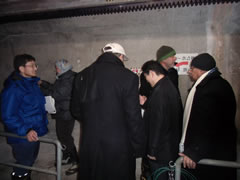 Naramata Dam
Naramata Dam
On the final day, the trainees visited Japan Association of Rural Solutions for Environmental Conservation and Resource Recycling (JARUS) to have a lecture on rural sewer system. These days, Egypt has been facing a challenging problem on quality of agricultural water. It is hoped that what they learned there including Japanese small –scaled dispersed treatment system, can give them some hints to solve their own problem. After the lecture, they were finally given the certificate to complete the training course and it was successfully ended.
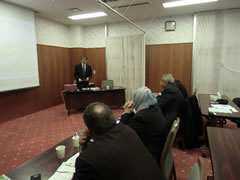 Lecture at JARUS
Lecture at JARUS
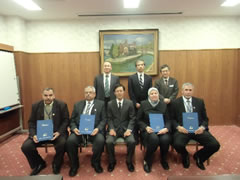 Closing Ceremony
Closing Ceremony
Although they had the busy and tight schedule of the training even this time, they seemed to be very satisfied with the contents of the training because they could effectively learn a lot of things in such short period. Since the SWMT Project will actively work on development of the roadmap on WMT from now on, we hope that the trainees will actively contribute to that activity by using what they actually learned in this training. Finally, we cordially thank all for their kind support to the training.
- About JICA
- News & Features
- Countries & Regions
- Our Work
- Thematic Issues
- Types of Assistance
- Partnerships with Other Development Partners
- Climate Change / Environmental and Social Considerations
- Evaluations
- Compliance and Anti-corruption
- Science and Technology Cooperation on Global Issues
- Research
- JICA Development Studies Program / JICA Chair
- Support for the Acceptance of Foreign HRs / Multicultural and Inclusive Community
- Publications
- Investor Relations
